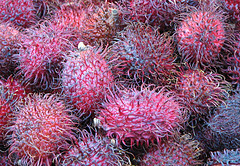Rambutans
| Infobox on Rambutans | |
|---|---|
| Example of Rambutans |  |
| Freshness facts | |
| Optimum carrying temperature | 8°C to 15°C° |
| Highest freezing point | - |
| Acceptable product temp. at loading into containers | Max. 2°C above carrying temperature |
| Optimum humidity | 90%-95% |
| Ventilation setting for containers | 25 m³/hr |
| Storage life | 2-3 weeks |
| Climacteric / non-climacteric | Non-climacteric |
| Ethylene production | High |
| Ethylene sensitivity | High |
| Modified / controlled atmosphere | 7%-12% CO2; 3%-5% O2 |
| Potential benefits | Reduced O2 - slight Increased CO2 - moderate |
| Availability | |
| Malaysia/Indonesia Central America |
February - August June - November |
Rambutans
Contents
Harvesting and handling
The rambutan is native to Malaysia and belongs to the same family as lychee. The rambutan is a medium-sized evergreen tree (12-25 m.) and grows only in the tropic. The fruit is covered with long fleshy protuberances (spinterns) which, depending on the cultivar, can be green, or the same colour as the skin. The skin colour of rambutans can vary from pink to deep crimson, and from yellow to yellow-orange. The fleshy translucent white flesh surrounds a single oblong seed, and is similar in flavour to a lychee, although somewhat less aromatic and juicy.
Quality criteria include: fruit size, shape, and weight; bright skin and spine colour; uniformity; absence of defects; and freedom from disease and insects.
Mechanical injury and dehydration are major causes of appearance loss.
Cooling and storage
Rambutan is best stored at 8°C to 15°C with 90% to 95% relative humidity to achieve a storage-life of 2-3 weeks. There may be changes in the skin and spine coloration after storage, but the flesh is unaffected. Over-ripe fruit have a watery texture, which may be a senescence-induced tissue breakdown.
Chilling injury and darkening of spines and skin are major postharvest disorders. Darkening is due to dehydration and mechanical injury. Pre-harvest disorders include skin splitting and poor filling of fruit. Skin splitting occurs in thin skinned cultivars often following heavy rains during the last phase of fruit growth. Poor filling has been associated with poor nutrition and dry conditions just after flowering.
Ethylene removal may, in some cases, retard ripening and reduce respiration rate. Modified atmosphere packaging has potential for maintaining quality. Low O2 retards senescence and lower respiration rate. Elevated CO2 slows red colour loss and extends the postharvest life.
Cautions
Rambutans are sensitive to moisture loss and high humidity is essential in minimising water loss and preventing skin darkening. Low O2 (below 1%) can increase decay incidence.
Storage disorders
Botryodiplodia Theobromae, Brown spot, Chilling injury, Physiological browning, Stem end rot.











